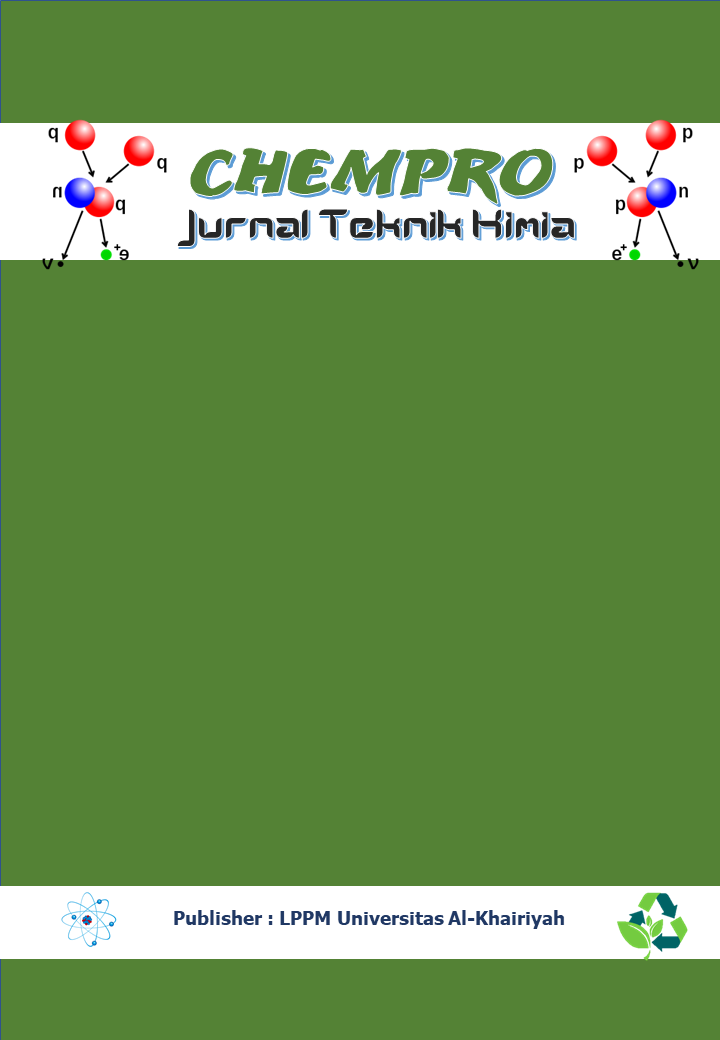Impact of the length of time in dwelling coconut milk to quantity of virgin coconut oil (VCO) obtained
Keywords:
Dwelling, Time, Virgin Coconut Oil (VCO)Abstract
Virgin Coconut Oil (VCO) is oil produced from fresh coconuts. Virgin Coconut Oil is different from coconut oil in
general, Virgin Coconut Oil (VCO) is produced at room temperature and there are no added chemicals. Virgin Coconut
Oil (VCO) has great benefits for health, this is because Virgin Coconut Oil (VCO) contains lots of medium chain fatty
acids (MCFA). The most abundant type of MCFA in Virgin Coconut Oil (VCO) is lauric acid. The easily absorbed
nature of MCFA will increase metabolism. It is hoped that the long standing time will increase the quantity of Virgin
Coconut Oil (VCO) obtained. The main process for making Virgin Coconut Oil (VCO) lies in separating oil from water
and protein. The process of separating Virgin Coconut Oil (VCO) from water and protein is carried out quietly, without
additional chemicals and centrifugation, so it does not require a lot of equipment to be used, the separation is carried
out by utilizing a lighter oil weight. Even though in this experiment only holding was carried out, this method is cheaper
in terms of production costs for Virgin Coconut Oil (VCO). This research was carried out using fresh coconut milk and
left for 1 hour to separate the thick coconut milk and water. Then the thick coconut milk is transferred into new plastic,
to get Virgin Coconut Oil (VCO), the thick coconut milk is left to stand for varying holding times of 24, 27 and 30
hours. After settling, 3 layers will be obtained consisting of protein (blondo), Virgin Coconut Oil (VCO) and water.
Then Virgin Coconut Oil (VCO) is separated from protein (blondo) and water. Virgin Coconut Oil (VCO) produced
by standing for 24 hours is: 56 mL of Virgin Coconut Oil (VCO) produced by standing for 27 hours is: 80 mL Virgin
Coconut Oil (VCO) produced from standing for 30 hours is: 98 mL. In the 30 hour variation of standing, the maximum
yield was obtained, namely 98 mL. Virgin Coconut Oil (VCO) was then subjected to organoleptic analysis, namely
observing that the color was clear like water, observing that the smell had a distinctive smell like coconut cake and
observing that the taste was tasteless.
References
Emilia, I., Panca Putri, Y., Novianti, D., &
Niarti, M. (2021). Pembuatan Virgin Coconut
Oil (VCO) dengan Cara Fermentasi di Desa
Gunung Megang Kecamatan Gunung Megang
Muara Enim. Jurnal Ilmiah Matematika Dan
Ilmu Pengetahuan Alam, 18(1).
https://doi.org/10.31851/sainmatika.v18i1.5679
Barlina, R., Torar, D., Penelitian, B., Kelapa, T.,
& Lain, P. (n.d.). Diversifikasi Produk Virgin
Coconut Oil (VCO).
Carandang, E. V. (2008). Health benefits of
virgin coconut oil.
Mansor, T. S. T., Man, C., Afiq, A., & Nurul, K.
(2012). Physicochemical properties of virgin
coconut oil extracted from different processing
methods. In International Food Research
(Marina et al., 2009)Journal (Vol. 19, Issue 3).
Moigradean, D., Poiana, M.-A., & Gogoasa, I.
(2012). Quality characteristics and oxidative
stability of coconut oil during storage (Vol. 18,
Issue 4). http://
Novarianto, H., & Tulalo, M. (n.d.).
KANDUNGAN ASAM LAURAT PADA
BERBAGAI VARIETAS KELAPA SEBAGAI
BAHAN BAKU VCO (Vol. 13, Issue 1).
Satheesh, N., & Prasad, N. B. L. (n.d.).
Production of Virgin Coconut Oil from Dry and
Wet Methods of Induced Fermentation and its
Characterization (Vol. 44, Issue 2).
https://www.researchgate.net/publication/2823
Srivastava, Y., Semwal, A. D., & Sharma, G. K.
(2018). Virgin Coconut Oil as Functional Oil. In
Therapeutic, Probiotic, and Unconventional
Foods (pp. 291–301). Elsevier.
https://doi.org/10.1016/B978-0-12-814625-
00015-7 Sanjeewani, A., Sakeena, M. H. F., &
Sanjeewani, N. A. (2013). Formulation and
Characterization of Virgin Coconut Oil (VCO)
Based Emulsion. International Journal of
Scientific and Research Publications, 3(12).
www.ijsrp.org
Wong, Y. C., & Hartina, H. (2014). Virgin
coconut oil production by centrifugation
method. Oriental Journal of Chemistry, 30(1),
–245. https://doi.org/10.13005/ojc/300129
Marina, A. M., Che Man, Y. B., Nazimah, S. A.
H., & Amin, I. (2009). Chemical properties of
virgin coconut oil. JAOCS, Journal of the
American Oil Chemists’ Society, 86(4), 301–
https://doi.org/10.1007/s11746-009-1351-
Masyithah, Z. (2017). Parametric study in
production of virgin coconut oil by fermentation
method. Oriental Journal of Chemistry, 33(6),
–3076.
https://doi.org/10.13005/ojc/330647
Dr. apt. Marisca Evalina Gondokesumo dkk,
Virgin Coconut Oil, Indonesia: Deepublish,
(International Academic Journal of Nutrition &
Food Sciences The Innovation of Coconut
Processing To Virgin Coconut Oil (VCO) Using
of the Centrifugal Method, n.d.)
Asiah, N., Astuti, R. M., Cempaka, L., & Setiani,
R. (2019). Physical and Chemical Characteristic
of Virgin Coconut Oil under Mix Culture
Fermentation Technique. Journal of Physics:
Conference Series, 1364(1).
/1364/1/012009
Hamid, M. A., Sarmidi, M. R., Mokhtar, T. H.,
Sulaiman, W. R. W., & Aziz, R. A. (2011).
Innovative integrated wet process for virgin
coconut oil production. Journal of Applied
Sciences, 11(13), 2467–2469.
https://doi.org/10.3923/jas.2011.2467.2469
Hamsi, M. A., Othman, F., Das, S., Kamisah, Y.,
Thent, Z. C., Qodriyah, H. M. S., Zakaria, Z.,
Emran, A., Subermaniam, K., & Jaarin, K.
(2015). Effect of consumption of fresh and
heated virgin coconut oil on the blood pressure
and inflammatory biomarkers: An experimental
study in Sprague Dawley rats . Alexandria
Journal of Medicine, 51(1), 53–63.
https://doi.org/10.1016/j.ajme.2014.02.002
Satheeshan, K., Author, C., Seema, B., & Meera
Manjusha, A. (2019). Quality analysis of virgin
coconut oil processed through different methods.
~ 2119 ~ Journal of Pharmacognosy and
Phytochemistry, 8(3).
Teguh Isworo Program Studi, J. S., &
PanganUniversitas Muhammadiyah Semarang,
T. (2013). PENGARUH LAMA FERMENTASI
PADA PRODUKSI MINYAK KELAPA
MURNI (VIRGIN COCONUT OIL)
TERHADAP SIFAT FISIK, KIMIA, DAN
ORGANOLEPTIK EFFECT OF
FERMENTATION TIME ON VIRGIN
COCONUT OIL (VCO) FOR CHARACTER
PHYSICAL, CHEMICAL, AND
ORGANOLEPTIC. In Jurnal Pangan dan Gizi
(Vol. 04, Issue 08)










